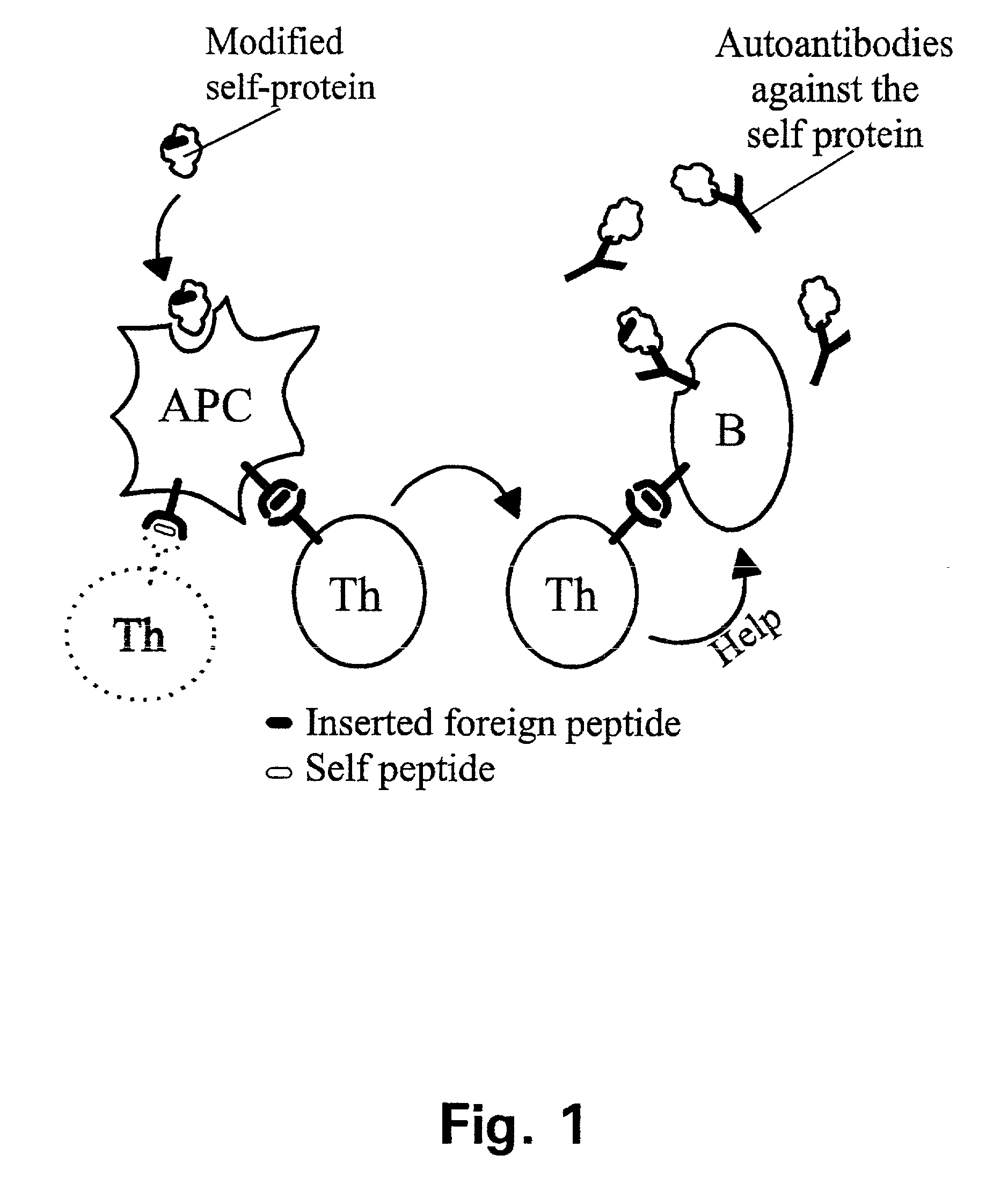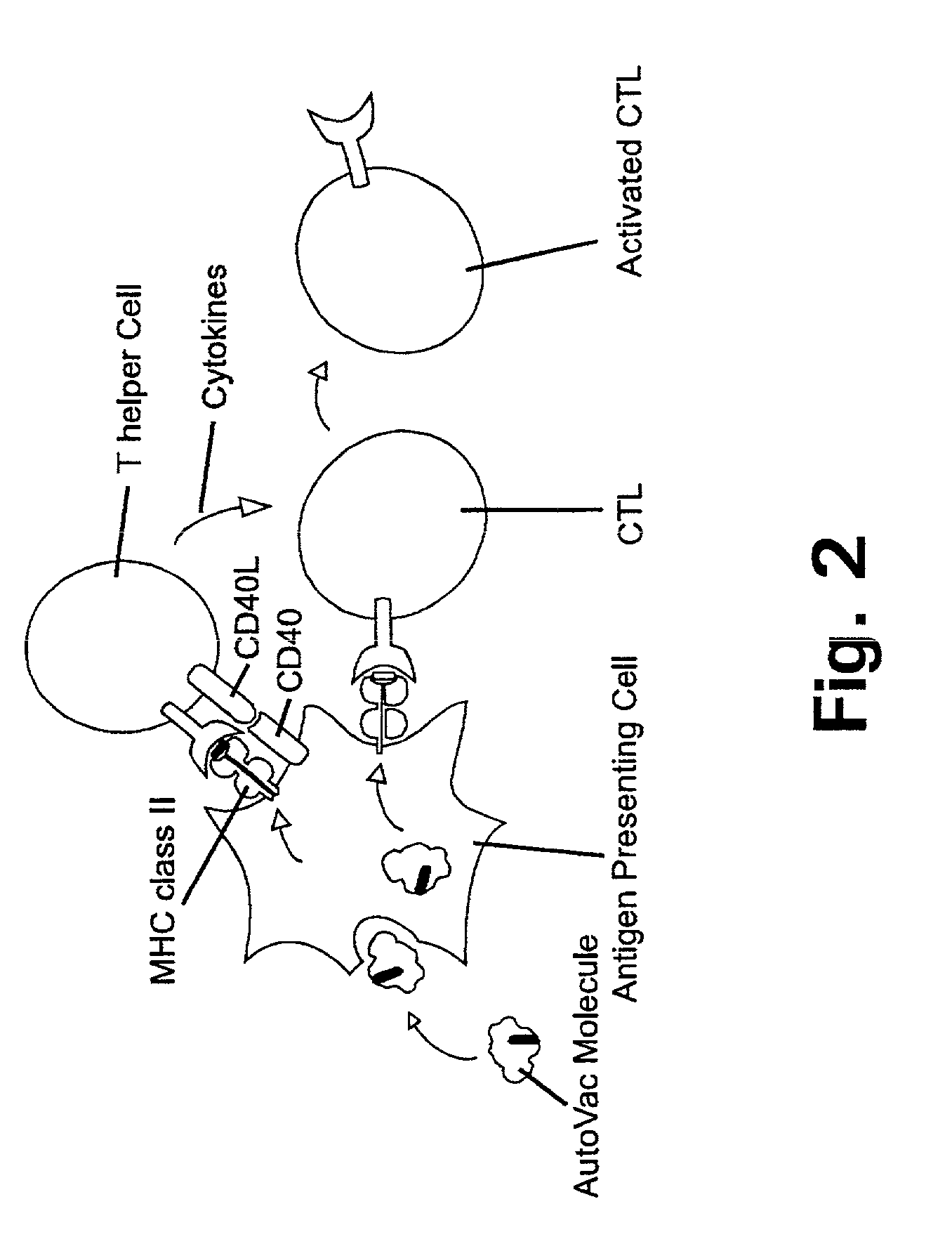Novel therapeutic vaccine formulations
a vaccine formulation and technology of a new type of vaccine, applied in the direction of biocide, plant growth regulator, cancer antigen ingredient, etc., can solve the problems of monoclonal antibody, less efficient treatment, and many serious problems
- Summary
- Abstract
- Description
- Claims
- Application Information
AI Technical Summary
Benefits of technology
Problems solved by technology
Method used
Image
Examples
example 1
[0190] Preparation of Chitosan Microparticles
[0191] 0.2 g of chitosan base (ChitoClear.TM. 804 from Primex Ingredients, Viscosity: 12 mPas measured in 1% in 1% acetic acid, deacetylation: 98.3%) and 0.8 g of Tween 80 is weighed out in a 100 ml beaker and brought into solution by addition of 80 ml of 2% acetic acid and subsequent stirring so as to obtain a solution of 0.25% chitosan, 1% Tween 80 and 2% acetic acid.
[0192] The beaker is placed in an ultrasound probe device (Soniprep 150, MSE) with a magnet stirring device. The solution is sonicated with a small probe for 30 min at 6 mA and magnetic stirring. Initially, sodium sulphate solution is added dropwise until particles precipitate (the amount and concentration can vary, e.g. 2 ml 10% sodium sulphate, 1 ml 20% sulphate etc.).
[0193] The particles are spun down in two 50 ml tubes at 5000 rpm for 20 min (Stratos Biofuge, Heraeus Instruments). The supernatant is isolated and resuspended in MilliQ water. Each batch is pooled in a tub...
example 2
[0197] Loading of Chitosan Microparticles with Ovalbumin
[0198] Solutions of 20 mg / ml chitosan particles in water are prepared as well as solutions of 20 mg / ml ovalbumin in water. 0.5 ml of each solution are mixed in an Eppendorf tube which is left to incubate for 3 hours at room temperature.
[0199] After 3 hours, the suspension is transferred to a 10 ml tube and 4 ml MilliQ is added. The resulting mixture is centrifuged at 10,000 rpm for 15 min. The supernatant is removed by suction and the pellet is resuspended in 5 ml MilliQ water. The mixture is centrifuged again. This procedure is repeated 3 times. The amount of ovalbumin in the supernatant (i.e. non-bound ovalbumin) is determined by means of a BCA assay:
[0200] A standard solution of ovalbumin in water containing 0.5 mg / ml is prepared. This standard is diluted to 0.4, 0.2, 0.1, 0.05 and 0.0125 mg / ml. 20 .mu.l per well of each of these 7 standards as well as a blind are added in triplicate to a flat-bottomed microtiter plate, cf. ...
example 3
[0203] Assaying of CTL Induction and T-Cell Proliferation
[0204] Mice have been injected subcutaneously with the following:
[0205] 1. 200 .mu.l ovalbumin-loaded (0.5 .mu.g / ml) chitosan particles prepared as above (10 .mu.g chitosan per 5 .mu.g ovalbumin).
[0206] 2. 200 .mu.l ovalbumin / chitosan mixture (0.5 .mu.g / ml ovalbumin and approximately same ratio between chitosan and ovalbumin).
[0207] 3. 200 .mu.l ovalbumin in Freund's complete adjuvant (0.5 .mu.g / ml ovalbumin).
[0208] 4. 200 ul of the peptide SIINFEKL (a known CTL epitope from ovalbumin) in Freund's complete adjuvant (0.5 .mu.g / ml SIINFEKL).
[0209] 5. 200 .mu.l ovalbumin in H.sub.2O (0.5 .mu.g / ml ovalbumin).
[0210] 6. 200 .mu.l H.sub.2O.
[0211] Ten days after last immunization, the mice were sacrificed and axillar and inguinal lymph nodes and the spleens were excised.
[0212] In a standard Chrome release assay for determination of CTLs lysing SIINFEKL-carrying cells, results have been obtained showing that CTLs were induced by the al...
PUM
| Property | Measurement | Unit |
|---|---|---|
| mean diameter | aaaaa | aaaaa |
| mean diameter | aaaaa | aaaaa |
| mean diameter | aaaaa | aaaaa |
Abstract
Description
Claims
Application Information
 Login to View More
Login to View More - R&D
- Intellectual Property
- Life Sciences
- Materials
- Tech Scout
- Unparalleled Data Quality
- Higher Quality Content
- 60% Fewer Hallucinations
Browse by: Latest US Patents, China's latest patents, Technical Efficacy Thesaurus, Application Domain, Technology Topic, Popular Technical Reports.
© 2025 PatSnap. All rights reserved.Legal|Privacy policy|Modern Slavery Act Transparency Statement|Sitemap|About US| Contact US: help@patsnap.com



